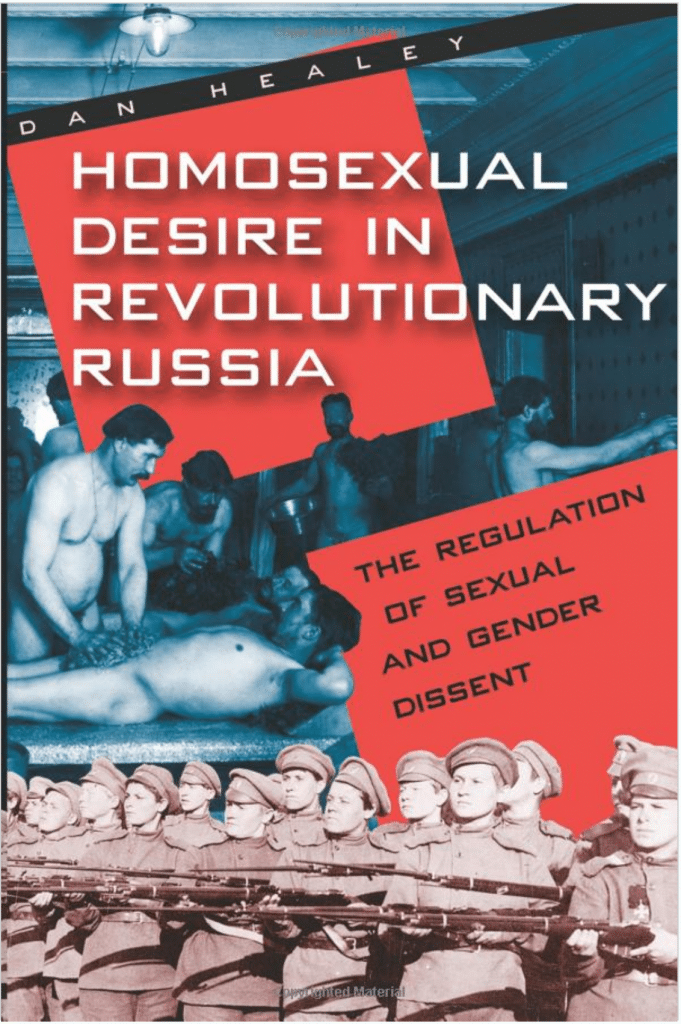The socialist October Revolution in 1917 brought about fundamental, thoroughgoing changes in Russian society. Millions of people in the largest country on Earth quickly found themselves far freer than they had ever been under the despotic, anti-Semitic Tsar, the strictures of the church, and the brutality of Russian capitalism and landlordism. Alongside the working class taking control of the Russian economy, the Russian Revolution also led to unprecedented advances in the liberation of women and LGBTQ people. In Homosexual Desire in Revolutionary Russia, Wales-based scholar Dan Healey relates the LGBTQ struggle in the Russian Revolution, the historic progressive gains made under Lenin and the Bolsheviks, and the later return under Stalin to state persecution and homophobic, sexist puritanism.
Massive Advances
Famously, the Russian Revolution brought the decriminalization of homosexuality in an act both nearly unique in Europe and astonishingly advanced in a country with semi-feudal conditions in vast parts where religious hierarchy had long been a cornerstone of the state. Healey reveals long-forgotten, even concealed, facts showing even greater advances: the early Soviet Union was the first industrialized state to recognize same-sex marriage, the USSR alongside Weimar Germany briefly led the world in gender corrective surgery, and Soviet medical experts working alongside transgender people began exploring the idea of gender not being a simple binary of man and woman but, instead, a spectrum.
Even as reformist socialists like the followers of Karl Kautsky took conservative views on sexuality in the early 20th century, the Russian Bolsheviks forged ahead because they were based on a movement from below. Same-sex marriage recognition occurred almost organically: two people of the same legal gender applied to be married, and local courts and officials in the wake of the Russian Revolution quickly decided there was no basis on which to deny the request.
Healey discusses at length the case of one of the parties to this marriage, anonymized as “Evgenii Fedorovich M.” Assigned female at birth, Evgenii Fedorovich struggled with gender identity and inconsistent support from family until the Russian Revolution gave him the chance to express himself as a man. While working as a political instructor far from his village of birth, he courted and married a woman, “S.”, and formed a family. Tragically, Evgenii Fedorovich’s reassignment to a distant city split the relationship and, suffering from psychiatric issues, he sank into alcoholism.
Revolutionary Rethinking of Sex and Gender
Evgenii Fedorovich’s discussions with Soviet psychiatrists informed a revolutionary political analysis of sex and gender. Healey devotes chapter six of his book to describing how Russian attitudes toward same-sex relationships quickly evolved from the Revolution to the end of the first Five Year Plan (1932) from challenging the idea of same-sex relationships as “perverse,” to medicalization, to the statement by biologist N. K. Kol’tsov that “there is no intermediate sex, but rather an infinite quantity of intermediate sexes.”
Several Soviet doctors were assembled into an expert commission, and ideas such as Kol’tsov’s found broad support. These doctors were being driven by experience: as soon as gender corrective surgery began to be practiced in the early 1920s, its practitioners were inundated with inquiries from ordinary Russians who had fought with their own bodies for their whole lives and finally saw a means of resolution.
Stalinist Reaction
While this commission of doctors put forward highly advanced ideas on gender and gender identity, their ideas were, tragically, never fully realized. With Stalin’s consolidation of power in the late 1920s came a vicious social reaction. In 1933, the Soviet state terminated the commission, and in 1936 it restored homosexuality to the status of a crime in Russia. The legacy of this reaction stands today, with some Stalinist groups around the world still spitting upon the ideas of transgender identity, transsexuality, homosexuality, and bisexuality as “undialectical.”
Why did this happen? When the working class had political power after 1917, it moved ahead as rapidly as possible with a vast transformation of Russian society, including liberating women from domestic servitude. But they faced daunting obstacles caused by the devastation of World War I and the Russian Civil War, compounded by the isolation of the revolution after the failure of revolutions in Western Europe. This created the space for the conservative bureaucracy and Stalin to seize political power from the working class in the 1920s. While maintaining the collectivized economy, the bureaucracy turned inward, away from world revolution, and they increasingly sought to give a social base to the regime through reverting to reactionary social ideology on the family, women’s role, and sexuality. They also increasingly promoted Russian nationalism.
Moreover, this reactionary attitude toward sexuality is, tragically, embraced in today’s capitalist Russia, as activists around the world shudder at the state-backed murder of gay people in Chechnya and ever-increasing legal and social homophobia in Russia under Putin.
Healey himself is no socialist, and his book presents the fascinating history of LGBTQ liberation in Russia through the lens of his own academic attitudes. Much of Healey’s terminology and his use of naming conventions seem, at best, dated. Nonetheless, the people he discusses and their heroic advances deserve to be far more than footnotes. They certainly deserve to be remembered in the U.S. where, despite significant gains made by the LBGTQ community, under today’s right-wing Trump administration and state-level Republican domination, states are once again charging ahead with anti-same-sex marriage legislation and purposefully transphobic “bathroom bills.”
Yet the best, most rational, most ethical arguments or plans for LGBTQ liberation mean nothing without a mass movement to back them up. Historic gains on LGBTQ rights made after the Russian Revolution were tragically lost in Stalin’s USSR due to the counter-revolutionary political expropriation of the working class. In the U.S. and around the world today, working people of all genders, orientations and identities must organize together, as a class, in order to stop the right wing assault, and to fight for the full freedom not just to exist but to love.


